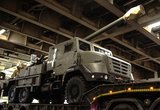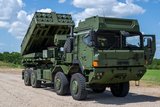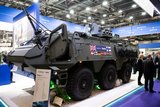Australia fires AIM-120 AMRAAM from NASAMS in move to replace RBS 70 MANPAD systems
The Australian DoD announced the successful test-firing on 18 November. (Photo: Australian DoD)
The Australian Army’s live-firing of a Raytheon AIM-120 AMRAAM (Advanced Medium-Range Air-to-Air Missile) from its new NASAMS system has marked a major step forward in the introduction of the system into service and has followed on from an order placed four years ago.
The new capability comprises an integrated system between a Kongsberg launch platform, a AIM-120 missile and radar, based on CEAMount fire control radar, from CEA Technologies.
It has been designed to provide protection from current and emerging air threats including indirect weapons, uncrewed aerial vehicles, air-delivered weapons and aircraft.
The firing took place at the Woomera test range in South Australia and was conducted by the 16th Regiment, Royal Australian Artillery, which will ultimately operate the system.
The project will see 16th Regiment move to new facilities at Edinburgh Defence Precinct in South Australia with relocation scheduled for late-2025.
The eventual introduction of the system into service will be a major capability enhancement for the Australian Defence Force replacing the less powerful RBS 70 man-portable air-defence (MANPAD) systems.
Chief of Army Lt Gen Simon Stuart said the firing was a substantial step towards meeting the challenges outlined in the Defence Strategic Review.
‘The firing of this world-class capability is a significant milestone for the modernisation of the army supported by defence industry partners,’ Stuart said. ‘NASAMS will enable the army to be interoperable with the wider Australian Defence Force and coalition militaries to provide integrated air and missile defence.’
More from Land Warfare
-
![Hungary set to begin using Hero 400 loitering munitions]()
Hungary set to begin using Hero 400 loitering munitions
Developed by Israel's Uvision and with systems being sold in the thousands to multiple European NATO countries and the US, the Hero family of loitering systems is also in production in the US and Italy, the latter through Rheinmetall.
-
![Croatia orders Leopards and CAESAR howitzers as Lithuania orders more CAESARs]()
Croatia orders Leopards and CAESAR howitzers as Lithuania orders more CAESARs
The Leopard is becoming the tank of choice in central and eastern Europe as Croatia joins Lithuania, the Czech Republic and Hungary in ordering the platform. Lithuania and Croatia have also signed for CAESAR howitzers.
-
![Light Reconnaissance Strike – enabling a vital mission set (Studio)]()
Light Reconnaissance Strike – enabling a vital mission set (Studio)
A new system-of-systems concept will unlock digital integration of sensors and weapons for Light Forces, allowing them to shape the battlefield environment on their own terms and upgrade legacy platforms.
-
![Lockheed Martin to look further afield for GMARS rocket system opportunities]()
Lockheed Martin to look further afield for GMARS rocket system opportunities
The HX truck is already in use in many NATO and allied countries around the world as a logistics vehicle and carrier for high-value systems, including missile firing weapons, so its use for the Global Mobile Artillery Rocket System makes logistical sense.
-
Medium knocked out of British Army LMP, with CAVS as heavyweight champion
As the British Army seeks to modernise and consolidate its diverse vehicle fleet, yet another change in direction is underway.

























